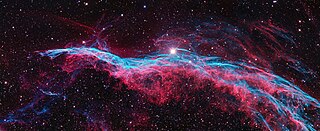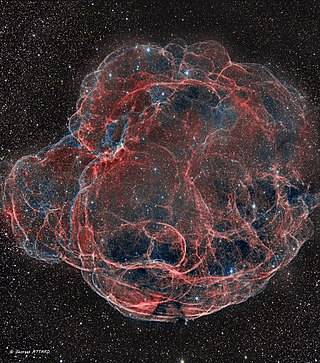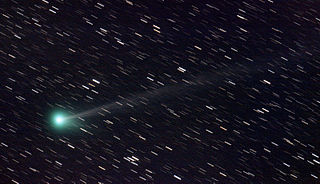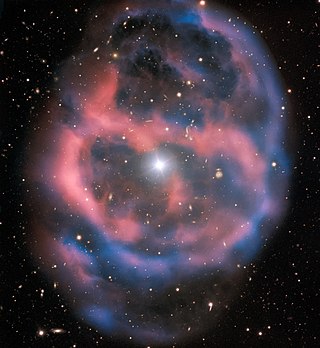
NGC 2264 is the designation number of the New General Catalogue that identifies two astronomical objects as a single object: the Cone Nebula, and the Christmas Tree Cluster. Two other objects are within this designation but not officially included, the Snowflake Cluster, and the Fox Fur Nebula. All of the objects are located in the Monoceros constellation and are located about 720 parsecs or 2,300 light-years from Earth. Due to its relative proximity and large size, it is extremely well-studied. NGC 2264 is sometimes referred to as the Christmas Tree Cluster and the Cone Nebula. However, the designation of NGC 2264 in the New General Catalogue refers to both objects and not the cluster alone. In December 2023, NASA released Christmas holiday-related images by the James Webb Space Telescope, including the Christmas Tree Galaxy Cluster and others.

The Eagle Nebula is a young open cluster of stars in the constellation Serpens, discovered by Jean-Philippe de Cheseaux in 1745–46. Both the "Eagle" and the "Star Queen" refer to visual impressions of the dark silhouette near the center of the nebula, an area made famous as the "Pillars of Creation" imaged by the Hubble Space Telescope. The nebula contains several active star-forming gas and dust regions, including the aforementioned Pillars of Creation. The Eagle Nebula lies in the Sagittarius Arm of the Milky Way.

Catalina Sky Survey is an astronomical survey to discover comets and asteroids. It is conducted at the Steward Observatory's Catalina Station, located near Tucson, Arizona, in the United States.

A transit of Mercury across the Sun takes place when the planet Mercury passes directly between the Sun and a superior planet. During a transit, Mercury appears as a tiny black dot moving across the Sun as the planet obscures a small portion of the solar disk. Because of orbital alignments, transits viewed from Earth occur in May or November. The last four such transits occurred on May 7, 2003; November 8, 2006; May 9, 2016; and November 11, 2019. The next will occur on November 13, 2032. A typical transit lasts several hours. Mercury transits are much more frequent than transits of Venus, with about 13 or 14 per century, primarily because Mercury is closer to the Sun and orbits it more rapidly.

Astronomy Picture of the Day (APOD) is a website provided by NASA and Michigan Technological University (MTU). It reads: "Each day a different image or photograph of our universe is featured, along with a brief explanation written by a professional astronomer." The photograph does not necessarily correspond to a celestial event on the exact day that it is displayed, and images are sometimes repeated. These often relate to current events in astronomy and space exploration. The text has several hyperlinks to more pictures and websites for more information. The images are either visible spectrum photographs, images taken at non-visible wavelengths and displayed in false color, video footage, animations, artist's conceptions, or micrographs that relate to space or cosmology.

Herschel is the largest impact crater on the Saturnian moon Mimas. It is located on Mimas's leading hemisphere, centered on the equator at 112° longitude. It is named after the 18th-century astronomer William Herschel, who discovered Mimas in 1789.

The Crescent Nebula is an emission nebula in the constellation Cygnus, about 5000 light-years away from Earth. It was discovered by William Herschel in 1792. It is formed by the fast stellar wind from the Wolf-Rayet star WR 136 colliding with and energizing the slower moving wind ejected by the star when it became a red giant around 250,000 to 400,000 years ago. The result of the collision is a shell and two shock waves, one moving outward and one moving inward. The inward moving shock wave heats the stellar wind to X-ray-emitting temperatures.
Solar physics is the branch of astrophysics that specializes in the study of the Sun. It intersects with many disciplines of pure physics and astrophysics.

The Veil Nebula is a cloud of heated and ionized gas and dust in the constellation Cygnus.
A gravitational mirage or cosmic mirage is an optical phenomenon affecting the appearance of a distant star or galaxy, seen only through a telescope. It can take the form of a ring or rings partially or completely surrounding the object, a duplicate image adjacent to the object, or multiple duplicate images surrounding the object. Sometimes the direct view of the original object itself is dimmed or absent.

A bipolar nebula is a type of nebula characterized by two lobes either side of a central star. About 10-20% of planetary nebulae are bipolar.

NGC 6357 is a diffuse nebula near NGC 6334 in the constellation Scorpius. The nebula contains many proto-stars shielded by dark discs of gas, and young stars wrapped in expanding "cocoons" or expanding gases surrounding these small stars. It is also known as the Lobster Nebula. This nebula was given the name War and Peace Nebula by the Midcourse Space Experiment scientists because of its appearance, which, in infrared images the bright, western part resembles a dove, while the eastern part looks like a skull. A petition by anime fans to rename it as the Madokami nebula, due to resemblance with a character, was unsuccessful.

Simeis 147, also known as the Spaghetti Nebula, SNR G180.0-01.7 or Sharpless 2-240, is a supernova remnant (SNR) in the Milky Way, straddling the border between the constellations Auriga and Taurus. It was discovered in 1952 at the Crimean Astrophysical Observatory by Grigory Shajn and his team using a Schmidt camera and a narrowband filter close to the Hydrogen Alpha transmission line. It is difficult to observe due to its extremely low surface brightness. This discovery was part of a survey conducted between 1945 and 1955, most likely using captured German equipment, as the observatory was practically destroyed during WWII. The Schmidt camera had a field of view of 175'. Many previously unknown hydrogen nebula were discovered this way, as they are not readily visible in regular photographs.

An airborne observatory is an airplane or airship with an astronomical telescope. By carrying the telescope to a sufficiently high altitude, the telescope can avoid cloud cover, pollution, and carry out observations in the infrared spectrum, above water vapor in the atmosphere which absorbs infrared radiation. Some drawbacks to this approach are the instability of the lifting platform, the weight restrictions on the instrument, the need to safely recover the gear afterward, and the cost compared to a comparable ground-based observatory.

The Dark Doodad Nebula is a dark nebula near the globular cluster NGC 4372, much closer than the centre of the galaxy and in the galactic plane, having a length of nearly three degrees of arc. Although officially unnamed, this long molecular cloud has come to be known under this name. It can be found in the southern constellation of Musca with strong binoculars.

C/2009 R1 (McNaught), one of more than fifty comets known as Comet McNaught, is a non-periodic comet discovered by British-Australian astronomer Robert H. McNaught on September 9, 2009, using the Uppsala Southern Schmidt Telescope at Siding Spring Observatory in New South Wales, Australia. The discovery was confirmed the same day at the Optical Ground Station telescope at Tenerife. After the discovery, earlier images of the comet were found from July 20, August 1, and August 18, 2009. It is believed that C/2009 R1 has left the Solar System permanently.
Robert J. Nemiroff is an Astrophysicist and Professor of Physics at Michigan Technological University. He received his Ph.D. from the University of Pennsylvania in Astronomy and Astrophysics in 1987 and his B.S. from Lehigh University in Engineering Physics in 1982. He is an active researcher with interests that include gamma-ray bursts, gravitational lensing, and cosmology, and is the cofounder and coeditor of Astronomy Picture of the Day (APOD), the home page of which receives over a million hits a day, approximately 20% of nasa.gov traffic. He is married and has one daughter.
Abell 7 is a faint planetary nebula located 1800 light-years away in the constellation of Lepus. It has a generally spherical shape about 8 light-years in diameter. Within the sphere are complex details that are brought out by narrowband filters. Abell 7 is estimated to be only 20,000 years old, but the central star, a fading white dwarf, is estimated to be some 10 billion years old.

Abell 36 is a faint barrel shaped planetary nebula located 780 light years from Earth in the constellation of Virgo. It was discovered by the American astronomer George Ogden Abell in 1955.
Thomas Ashcraft is an American astronomer, naturalist, scientific instrument-maker, and artist. He is known for his observations of transient luminous events, meteoric fireballs, solar radio and optical phenomena, and Jupiter radio emissions.


















